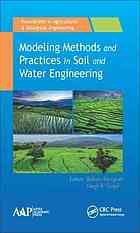Product desciption
Modeling Methods And Practices In Soil And Water Engineering Goyal by Goyal, Megh Raj; Panigrahi, Balram 9781771883276, 1771883278 instant download after payment.
"The book contains 12 chapters spreading over three parts: Modeling Methods in Soil and Water Engineering, Research Innovations in Soil and Water Engineering, and Irrigation Management of Crops. The first section covers various modeling methods, including groundwater recharge estimation, rainfall-runoff modeling using artificial neural networks, development and application of a water balance model and a HYDRUS-2D model for cropped fields, a multi-model approach for stream flow simulation, multi-criteria analysis for construction of groundwater structures in hard rock terrains, hydrologic modeling of watersheds using remote sensing, and GIS and AGNPS. The effects of climate change on water resources planning and management and sustainable urban drainage systems are discussed in the book's second section. A specialized chapter deals with applications of remote sensing and GIS for watershed planning and management. Irrigation water for agriculture is diminishing day by day, which affects rice production in many rice-growing countries. The third section addresses productivity of rice under deficit irrigation and suggests different water-saving irrigation techniques to help in obtaining optimum yield. Finally methods to estimate water requirement of different crops and performance of plantation crops in degraded watersheds under different conservation trenches are discussed. The book will serve as a reference manual for graduate and undergraduate students of agriculture and agricultural, civil, and biological engineering and will also be valuable for those who teach, practice, and research soil and water conservation methods for agriculture."--
Abstract: "The book contains 12 chapters spreading over three parts: Modeling Methods in Soil and Water Engineering, Research Innovations in Soil and Water Engineering, and Irrigation Management of Crops. The first section covers various modeling methods, including groundwater recharge estimation, rainfall-runoff modeling using artificial neural networks, development and application of a water balance model and a HYDRUS-2D model for cropped fields, a multi-model approach for stream flow simulation, multi-criteria analysis for construction of groundwater structures in hard rock terrains, hydrologic modeling of watersheds using remote sensing, and GIS and AGNPS. The effects of climate change on water resources planning and management and sustainable urban drainage systems are discussed in the book's second section. A specialized chapter deals with applications of remote sensing and GIS for watershed planning and management. Irrigation water for agriculture is diminishing day by day, which affects rice production in many rice-growing countries. The third section addresses productivity of rice under deficit irrigation and suggests different water-saving irrigation techniques to help in obtaining optimum yield. Finally methods to estimate water requirement of different crops and performance of plantation crops in degraded watersheds under different conservation trenches are discussed. The book will serve as a reference manual for graduate and undergraduate students of agriculture and agricultural, civil, and biological engineering and will also be valuable for those who teach, practice, and research soil and water conservation methods for agriculture."


